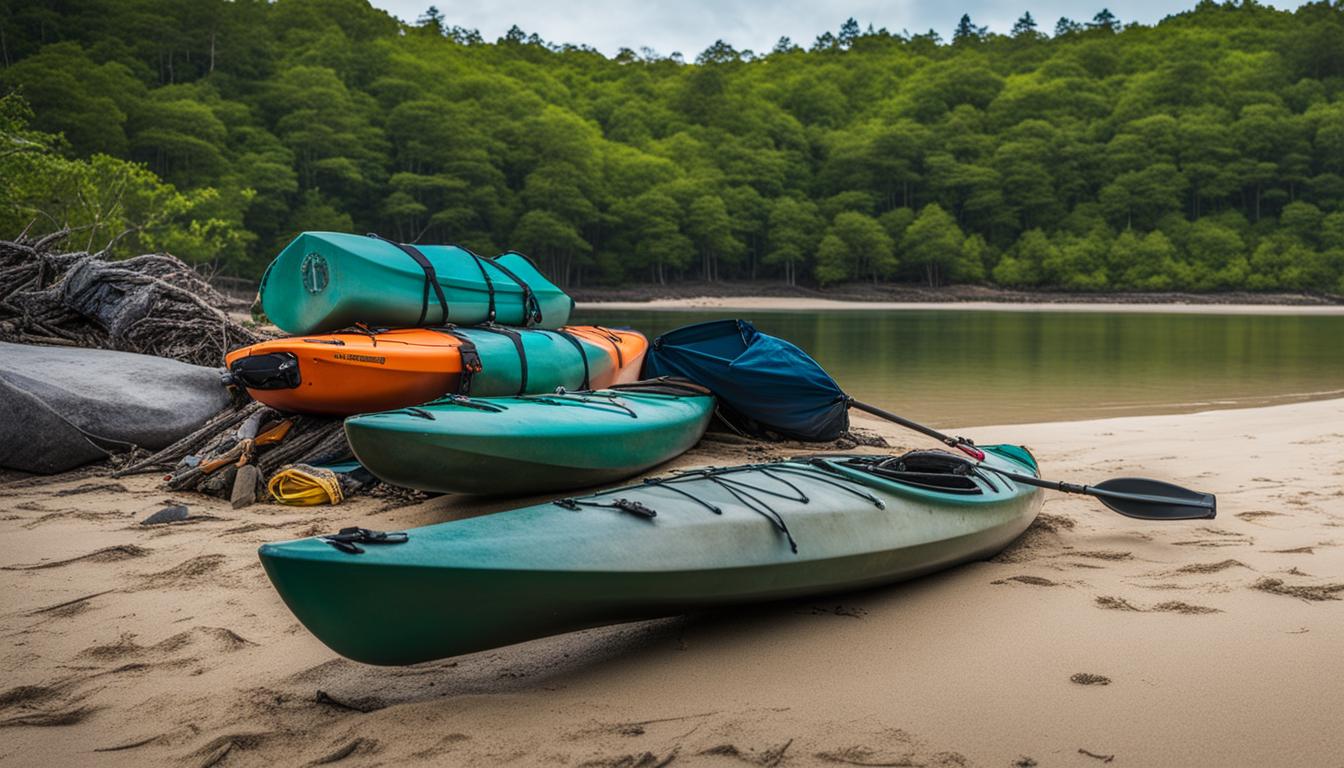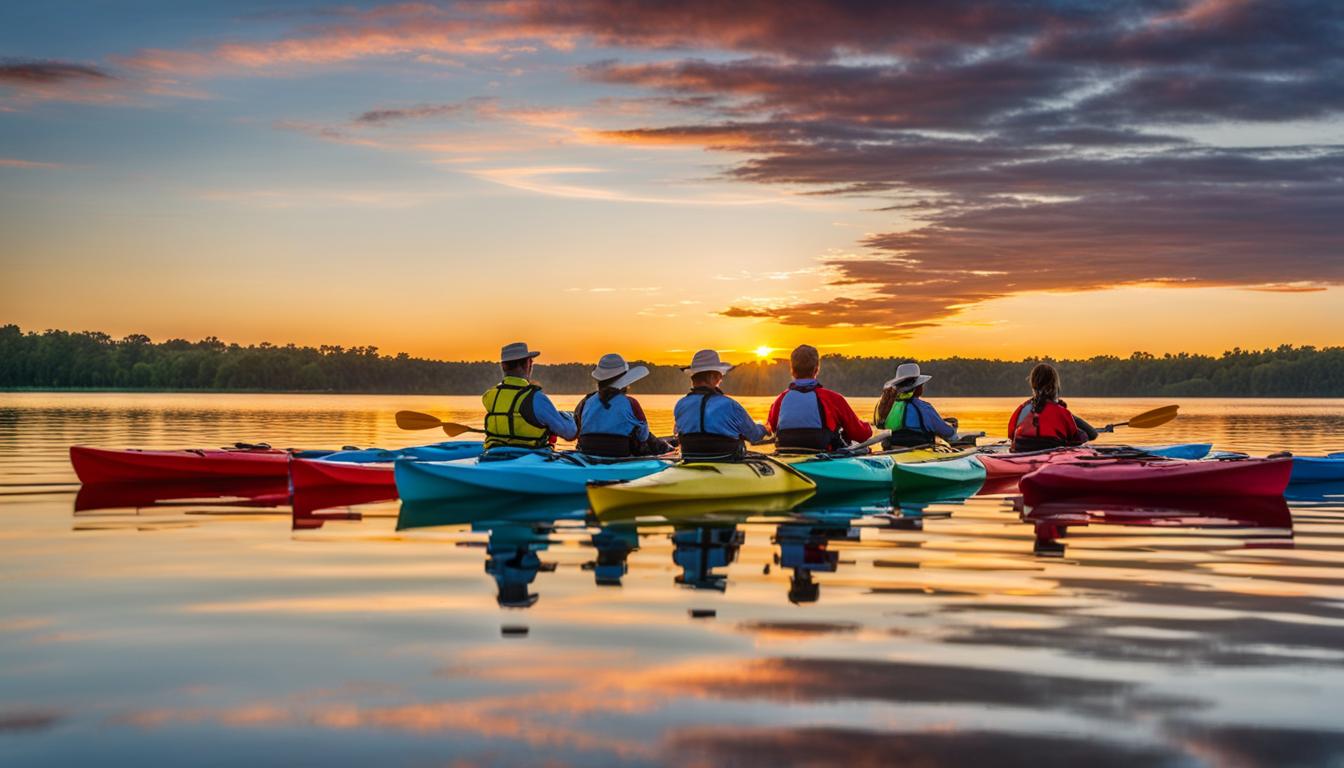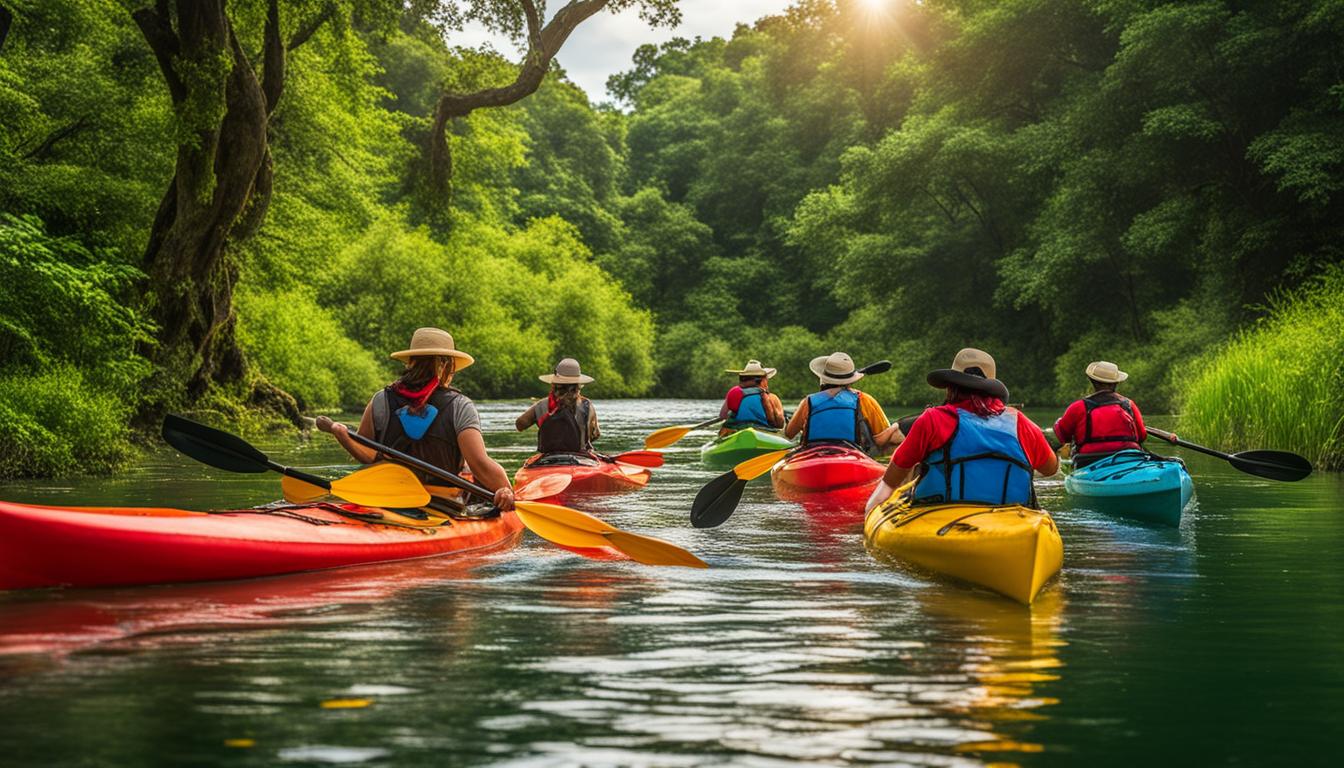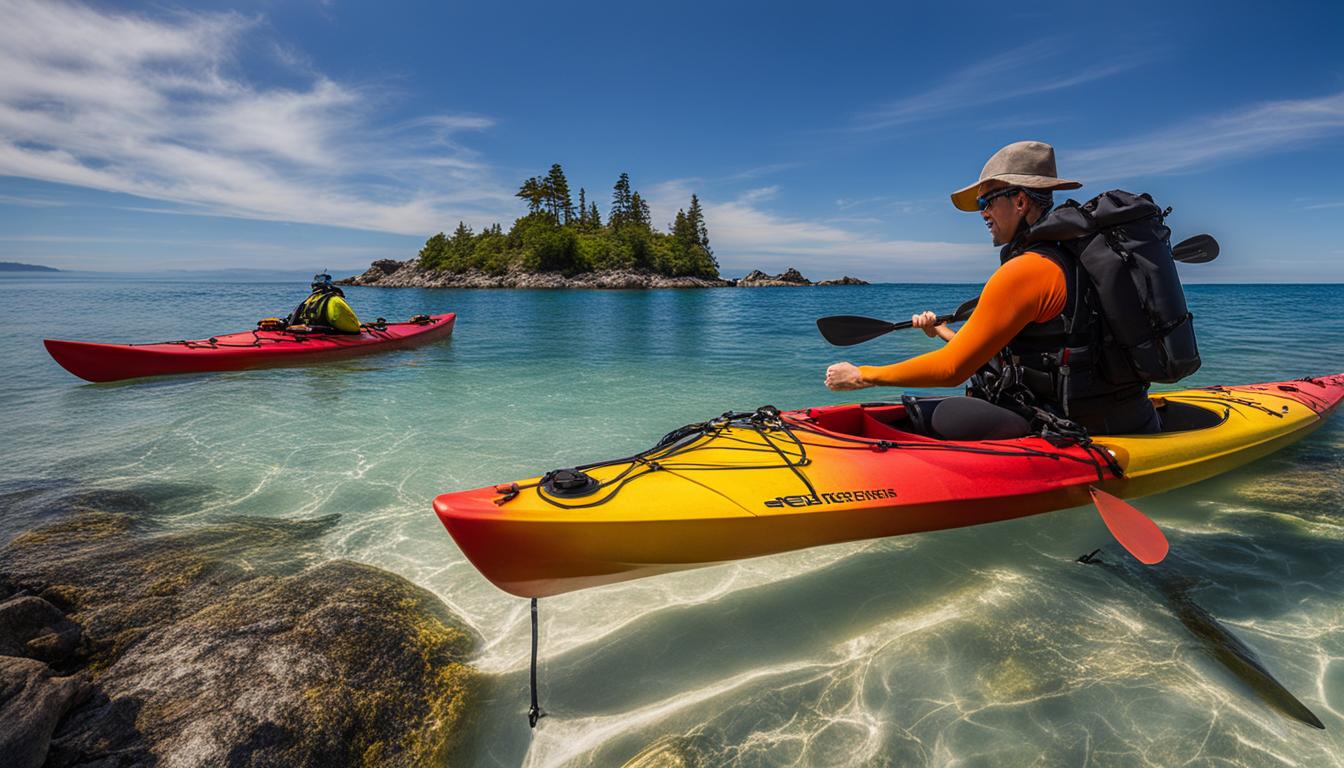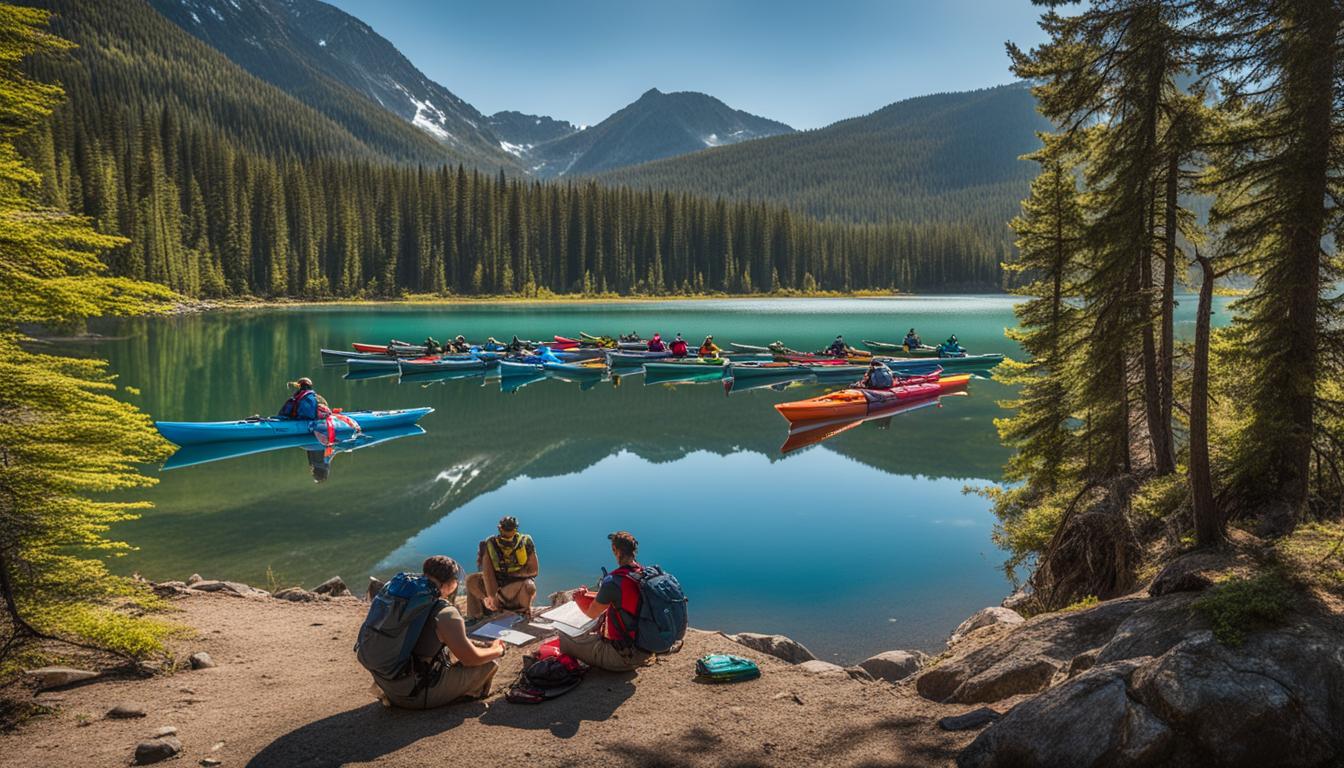When enjoying the beauty of the great outdoors through kayak camping, it is crucial to be mindful of the environmental impact we have. By practicing eco-friendly techniques and adopting sustainable habits, we can minimize our camping footprint and preserve nature for future generations. This article will explore the Leave No Trace principles that are essential for responsible and ethical kayak camping, guiding you on how to minimize your impact and be considerate of the environment and other visitors.
Key Takeaways:
- Leave No Trace principles are crucial for minimizing the environmental impact of kayak camping.
- By planning ahead and preparing, kayakers can ensure a successful and eco-friendly trip.
- Concentrating use on durable surfaces helps to minimize damage to natural areas.
- Proper waste disposal, including packing out trash and managing human waste, is essential for Leave No Trace camping.
- Leaving natural features undisturbed and minimizing campfire impacts are important aspects of kayak camping ethics.
Plan Ahead and Prepare
Proper planning is key to a successful and eco-friendly kayak camping trip. By taking the time to plan ahead and prepare, you can ensure a safe and enjoyable experience while minimizing your impact on the environment. Here are some Leave No Trace planning tips to help you get started:
Research Your Destination
Before embarking on your kayak camping adventure, it’s important to thoroughly research your destination. Familiarize yourself with any regulations or permits required for camping in the area. Take note of any hazards, such as strong currents or unpredictable weather conditions. Study maps and topographic information to get a better understanding of the terrain you’ll be navigating.
Schedule and Prepare
Once you’ve chosen your destination, it’s time to schedule your trip. Make sure to obtain any necessary permits well in advance. Check tide tables to plan your paddling schedule accordingly. Prepare a detailed itinerary, including estimated distances and camping locations. Pack appropriate gear, ensuring you have everything you need for a safe and comfortable kayak camping experience.
Plan Your Meals
Another important aspect of planning ahead is meal preparation. Plan your meals carefully to minimize waste and reduce your environmental impact. Consider lightweight, easily packable foods that require minimal cooking or cleanup. Opt for reusable containers and utensils instead of single-use items. By planning your meals thoughtfully, you can enjoy delicious and eco-friendly meals while kayak camping.
| Leave No Trace Planning Tips |
|---|
| Research your destination thoroughly, including regulations and hazards. |
| Schedule your trip in advance and obtain any necessary permits. |
| Check tide tables and plan your paddling schedule accordingly. |
| Prepare a detailed itinerary, including estimated distances and camping locations. |
| Pack lightweight, easily packable foods and reusable containers and utensils. |
Travel and Camp on Durable Surfaces
When kayak camping, it is important to be mindful of the surfaces you travel on and camp on to minimize damage to natural areas. By choosing durable surfaces, you can protect the environment and preserve the beauty of your surroundings. Durable surfaces include established trails and campsites, bare rock, beaches, gravel bars, dry grasses, unvegetated forest duff, and snow. These surfaces can withstand the impact of camping and minimize the disturbance to the delicate ecosystems.
Before embarking on your kayak camping trip, it is recommended to inquire with local staff or consult reliable resources to determine the best durable surfaces for your journey. Each destination may have specific guidelines and recommendations for camping spots. By adhering to these guidelines, you can ensure that you are camping in areas that can handle the impact and have been designated as suitable for camping.
Additionally, it is crucial to establish a low impact strategy for your campsites. This includes practicing Leave No Trace principles such as dispersing use in pristine areas, avoiding site modification, and using camp stoves instead of building fires. Camp stoves not only reduce the risk of wildfires but also minimize the impact on the surrounding vegetation. By being mindful of the surfaces you travel on and camp on, you can enjoy your kayak camping experience while minimizing damage to natural areas and respecting the environment.
| Durable Surfaces | Benefits | Considerations |
|---|---|---|
| Established Trails and Campsites | – Minimal impact on surrounding vegetation – Designated areas for camping – Contribute to trail maintenance and preservation |
– Limited availability in remote areas – May require permits or reservations |
| Bare Rock | – No impact on vegetation – Provides a solid and stable surface for camping – Offers scenic views |
– Limited availability in some areas – Can be slippery when wet |
| Beaches | – Easy access to water – Soft sand provides comfortable camping surface – Can enjoy beach activities |
– High demand in popular areas – Limited privacy |
| Gravel Bars | – Natural and stable surface for camping – Provides access to water – Offers a peaceful camping experience |
– Limited availability in some areas – Can be prone to erosion |
Quote:
“Choosing durable surfaces for kayak camping is not only about preserving the environment but also ensuring a positive experience for future visitors. By being mindful of where you travel and camp, you can help maintain the natural beauty of these areas for generations to come.”
— Leave No Trace Expert
Dispose of Waste Properly
Proper waste disposal is a crucial aspect of Leave No Trace principles in kayak camping. By packing out trash and garbage, you can ensure that you are minimizing your impact on the environment and leaving the natural beauty of the waterways undisturbed. Make sure to bring extra bags specifically designated for packing out trash, and inspect your campsite thoroughly before moving on to ensure nothing is left behind.
In addition to packing out trash, it is important to know how to properly dispose of human waste while kayaking. Solid waste should always be packed out and disposed of in designated waste receptacles. However, if there is no available toilet, diluted waste waters can be disposed of below the high tide line to prevent contamination of natural areas. Remember to pack out toilet paper and hygiene products as well, as these can have a negative impact on the environment if left behind.
Good sanitation practices are also essential to minimize your impact while kayak camping. This includes washing your hands and practicing good hygiene to prevent the spread of bacteria and diseases. By following these Leave No Trace principles for waste disposal and sanitation, you can ensure that you are leaving minimal trace behind and preserving the natural beauty of the waterways for future generations.
Leave No Trace Sanitation Tips:
- Pack out all trash and garbage
- Inspect your campsite before moving on
- Dispose of solid waste in designated waste receptacles
- Dispose of diluted waste waters below the high tide line if no toilet is available
- Pack out toilet paper and hygiene products
- Practice good sanitation and hygiene
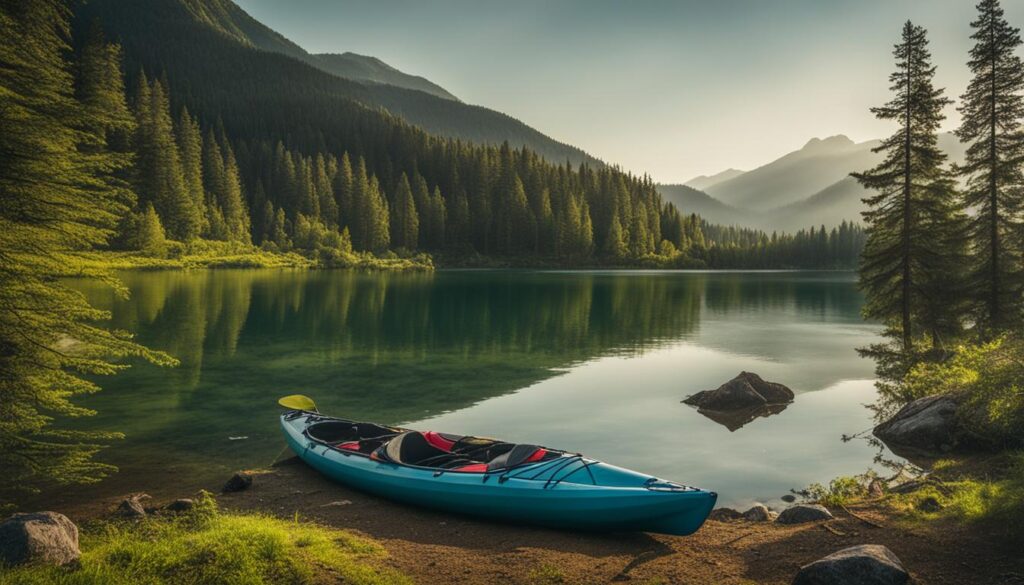
| Items to Pack Out | Items to Dispose of Properly |
|---|---|
| Food wrappers | Human waste |
| Plastic bottles | Trash and garbage |
| Empty cans | Toilet paper and hygiene products |
| Disposable utensils |
Leave What You Find
While kayak camping, it is important to practice Leave No Trace principles and leave natural features undisturbed. Preserving the natural beauty of the environment ensures that future generations can also enjoy the same experiences as we do. By being mindful of our impact, we can minimize damage and maintain the integrity of the ecosystems we explore. Taking the time to appreciate and respect the natural features we encounter is an essential part of responsible kayak camping.
One way to leave what you find is to avoid excavating or disturbing cultural or historic structures and artifacts. These remnants of the past hold significant value and should be left untouched for others to discover and learn from. Additionally, refraining from removing rocks, plants, or other elements from their natural surroundings helps maintain the delicate balance of the ecosystem. By leaving the natural features as we found them, we contribute to the preservation of these unique and irreplaceable environments.
Another aspect of leaving what you find is preventing the spread of invasive species. Invasive species can have detrimental effects on ecosystems by outcompeting native plants and animals. To minimize the risk of spreading invasive species, it is important to wash your kayak and gear after each trip. By removing any potential hitchhikers, such as seeds or larvae, we can help prevent the introduction and establishment of invasive species in kayak camping areas. Let’s do our part in protecting the natural habitats we explore.
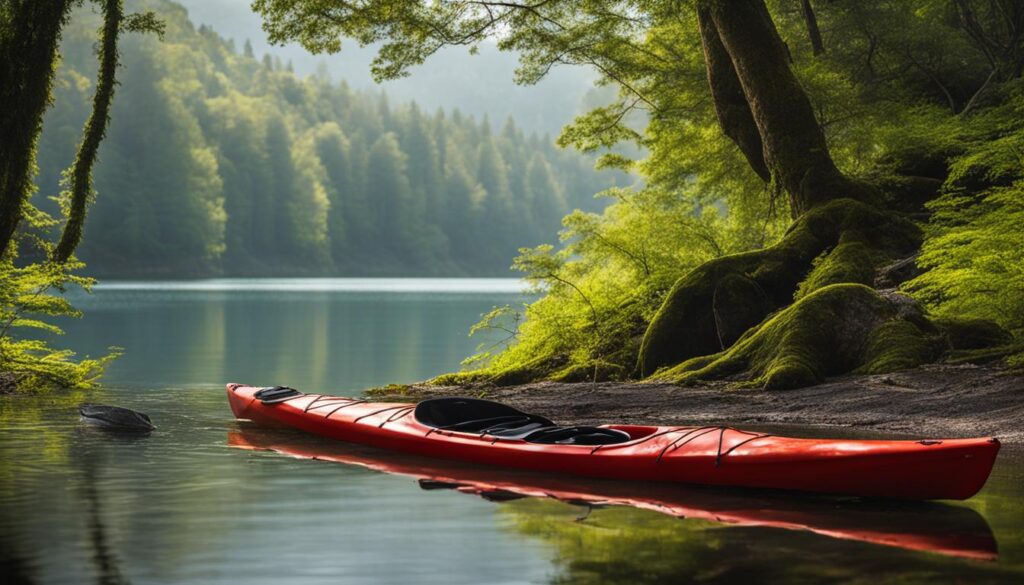
Remember, practicing Leave No Trace principles in kayak camping is not just about minimizing our impact during our trips, but also preserving the environment for future generations. By leaving what we find and preventing the spread of invasive species, we can ensure that these pristine areas remain untouched and continue to provide awe-inspiring experiences for all who visit.
Minimize Campfire Impacts
Minimizing campfire impacts is crucial for practicing Leave No Trace principles in kayak camping. To ensure a safe and eco-friendly experience, it is recommended to use camp stoves instead of building fires. Camp stoves are a more efficient and sustainable way to cook meals while minimizing the risk of fire damage to the environment. Additionally, using stoves allows you to have more control over the cooking process and reduces the chances of accidentally starting a wildfire.
If building a fire is necessary, it is important to keep it below the high tide line. This helps to prevent the fire from spreading and causing damage to surrounding vegetation. When gathering wood for a fire, only use dead and downed wood that is found on the ground. Avoid cutting or damaging live trees, as this can have long-term effects on the local ecosystem. Remember to never transport wood from one area to another, as it can introduce invasive insects and diseases to new environments.
When managing a campfire, always ensure that it is attended and never leave it unattended. It is also essential to properly extinguish the fire before leaving the campsite or going to bed. Completely douse the fire with water, stir the ashes, and douse it again to ensure that it is fully extinguished. Disguise the fire area by scattering cool ashes and natural materials, leaving it as you found it. By taking these precautions, you can minimize the impact of campfires and enjoy your kayak camping trip in a responsible and sustainable manner.
Fire Safety Tips for Kayak Camping
- Use camp stoves instead of campfires to minimize the risk of fire damage and promote eco-friendly practices.
- If building a fire is necessary, keep it below the high tide line to prevent the fire from spreading.
- Only use dead and downed wood that is found on the ground when gathering wood for a fire.
- Never cut or damage live trees, as it can have long-term effects on the local ecosystem.
- Never transport wood from one area to another to avoid introducing invasive insects and diseases.
- Always attend the campfire and never leave it unattended.
- Properly extinguish the fire before leaving the campsite or going to bed by dousing it with water and stirring the ashes.
- Disguise the fire area by scattering cool ashes and natural materials, leaving it as you found it.
By following these fire safety tips and minimizing campfire impacts, you can ensure a safe and environmentally conscious kayak camping experience. Remember, Leave No Trace principles are essential for preserving the natural beauty of our waterways and protecting the environment for future generations.
Conclusion
Practicing Leave No Trace principles in kayak camping is of utmost importance when it comes to preserving the natural beauty of our waterways and protecting the environment. By following these principles, you can ensure an eco-friendly and sustainable kayak camping experience.
It is essential to understand the importance of Leave No Trace principles in kayak camping. By minimizing your impact and adopting eco-friendly practices, you can minimize your camping footprint and preserve nature for future generations.
Remember to plan ahead and prepare for your trips, travel and camp on durable surfaces, dispose of waste properly, leave natural features undisturbed, and minimize campfire impacts. These practices, along with respecting wildlife and being considerate of other visitors, will help you leave minimal trace behind while enjoying your kayak camping adventures.
FAQ
What are Leave No Trace principles?
Leave No Trace principles are a set of guidelines that promote responsible and sustainable outdoor practices. They aim to minimize the environmental impact of outdoor activities and help preserve the natural beauty of the wilderness.
Why are Leave No Trace principles important for kayak camping?
Leave No Trace principles are essential for minimizing the environmental impact of kayak camping. By following these principles, kayakers can minimize their camping footprint, preserve nature, and be considerate of the environment and other visitors.
How can I practice Leave No Trace principles while kayak camping?
To practice Leave No Trace principles while kayak camping, it is important to plan ahead and prepare, travel and camp on durable surfaces, dispose of waste properly, leave what you find, minimize campfire impacts, respect wildlife, and be considerate of other visitors.
What should I do to plan ahead and prepare for a kayak camping trip?
To plan ahead and prepare for a kayak camping trip, you should educate yourself about your destination, including regulations, hazards, topography, and facilities. It is important to match your skills, behavior, and group size with the type of destination and schedule your trip in advance by obtaining permits, checking tide tables, and studying maps.
How can I travel and camp on durable surfaces during kayak camping?
To travel and camp on durable surfaces during kayak camping, you should concentrate use on established trails and campsites, bare rock, beaches, gravel bars, dry grasses, unvegetated forest duff, and snow. It is important to inquire with local staff to determine the best durable surfaces for your trip and establish a low impact strategy for your campsites.
What should I do to dispose of waste properly while kayak camping?
To dispose of waste properly while kayak camping, you should pack out all trash and garbage, inspect your campsite before moving on, and bring extra bags to take away any trash you may find. When it comes to human waste, you should pack out solid waste and dispose of diluted waste waters below the high tide line if there is no available toilet. It is important to pack out toilet paper and hygiene products and practice good sanitation to prevent contamination in natural areas.
How can I leave what I find during kayak camping?
To leave what you find during kayak camping, you should avoid excavating, disturbing, or removing cultural or historic structures and artifacts. It is important to appreciate and respect the natural beauty of the area and leave it as you found it. In addition, you should take precautions to avoid spreading invasive species by washing your boats and gear after each trip.
How can I minimize campfire impacts while kayak camping?
To minimize campfire impacts while kayak camping, it is recommended to use camp stoves instead of building fires. If a fire is necessary, it should be kept below the high tide line and use only found wood that is dead, downed, and distant from the campsite. Campfires should be managed carefully and never left unattended. It is also important to disguise the fire area and leave it as you found it.

